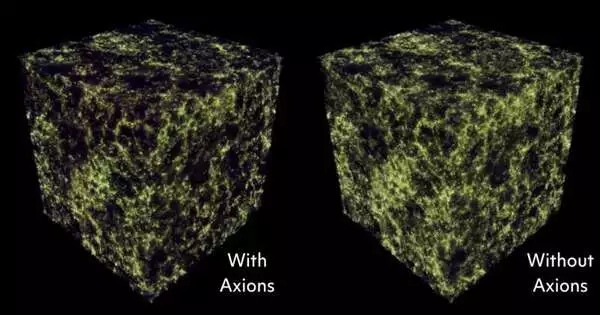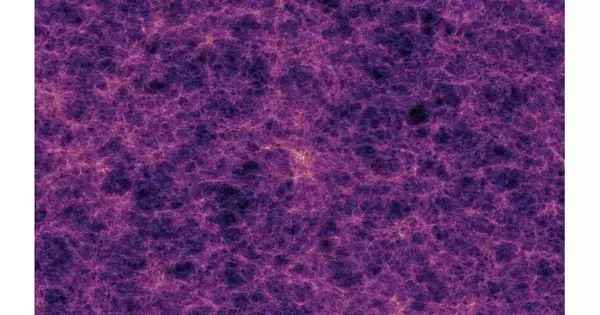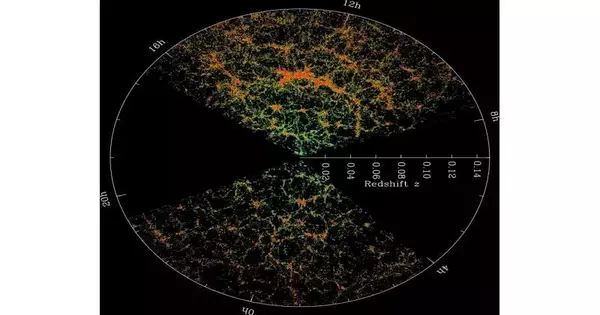Researchers from the University of Toronto present a theoretical breakthrough in a study that was recently published in the Journal of Cosmology and Astroparticle Physics. This discovery has the potential to explain both the nature of invisible dark matter and the cosmic web, the vast structure of the universe. This new connection between these two long-standing astronomy issues opens up new avenues for comprehending the universe.
The “clumpiness problem,” which refers to the unexpectedly even distribution of matter on large scales throughout the cosmos, may indicate that dark matter is made up of a hypothetical class of ultra-light particles known as axions, according to the research. Beyond our understanding of dark matter, the discovery of hard-to-detect axions could shed light on fundamental questions about the universe as a whole.
“Finding axion dark matter would be one of the most significant discoveries of this century if confirmed with future telescope observations and laboratory experiments,” says lead author Keir Rogers, a Dunlap Fellow at the Dunlap Institute for Astronomy & Astrophysics in the Faculty of Arts & Science at the University of Toronto.
“Finding axion dark matter would be one of the most significant discoveries of this century if confirmed by future telescope observations and laboratory experiments,”
lead author Keir Rogers, Dunlap Fellow at the Dunlap Institute for Astronomy & Astrophysics.
“At the same time, our results suggest an explanation for why the universe is less clumpy than we thought. This observation has become increasingly clear over the last decade or so, and at this point, our theory of the universe is uncertain.”
Because it does not interact with light, dark matter, which accounts for 85% of the mass of the universe, cannot be seen. To comprehend how matter is distributed throughout the universe, scientists investigate its gravitational effects on matter that can be seen.
A computer simulation of a portion of the universe with and without axions demonstrates that the structure of the dark matter cosmic web is less clumpy when axions are present. The Milky Way galaxy would be contained within one of the tiny green halos for scale. Credit: Alex Lagu/Alex Spencer London.
Dark matter is thought to be composed of axions, which are referred to in quantum mechanics as “fuzzy” because of their wave-like behavior. Axions can have wavelengths that are larger than galaxies as a whole, in contrast to discrete point-like particles. Dark matter’s formation and distribution may be influenced by this fuzziness, which could explain why the universe is less clumped than expected in an axiom-free universe.
Large-scale surveys of galaxies have revealed this lack of clumpiness, which challenges the other prevalent theory that dark matter is only composed of heavy subatomic WIMPs with weak interactions. There is no evidence to suggest that WIMPs exist, despite experiments like the Large Hadron Collider.
Rogers asserts, “In science, new discoveries and old problems are solved when ideas break down.”
Cosmic Microwave Background (CMB) observations from the Planck 2018, Atacama Cosmology Telescope, and South Pole Telescope surveys were analyzed by the research team, which was led by Rogers and included members of associate professor Renée Hloek’s research group at the Dunlap Institute, as well as from the University of Pennsylvania, Institute for Advanced Study, Columbia University, and King’s College London.

A computer simulation of a portion of the universe with and without axions demonstrates that the structure of the dark matter cosmic web is less clumpy when axions are present. The Milky Way galaxy would be contained within one of the tiny green halos for scale. Credit: Alexander Spencer London/Alex Laguë.
The Baryon Oscillation Spectroscopic Survey (BOSS) galaxy clustering data, which maps the positions of approximately a million galaxies in the nearby universe, was compared by the researchers to these CMB data. They measured fluctuations in the amount of matter throughout the universe and confirmed its reduced clumpiness in comparison to predictions by studying the distribution of galaxies, which reflects the behavior of dark matter under gravitational forces.
The researchers then predicted the appearance of relic light and the distribution of galaxies in a universe with long dark matter waves through computer simulations. Supporting the hypothesis that fuzzy axions might be to blame for the clumpiness issue, these calculations were in line with Big Bang CMB and galaxy clustering data.
Large-scale surveys to map millions of galaxies and provide precise measurements of clumpiness will be part of future research, as will observations made with the Rubin Observatory over the next ten years.
Through gravitational lensing, the effect in which dark matter clumpiness is measured by how much it bends the light from distant galaxies like a huge magnifying glass, the researchers hope to compare their theory to direct observations of dark matter. In order to verify their findings even further, they plan to investigate the mechanisms by which galaxies release gas into space and how this affects the distribution of dark matter.

Gravity creates a vast web of filaments that connect galaxies and clusters of galaxies via invisible bridges hundreds of millions of light-years apart in order to shape the universe. The term for this is the cosmic web. Credit: Volker Springel (Max Planck Institute for Astrophysics) et al.
One of the most pressing fundamental questions and the key to understanding the universe’s origin and future is the nature of dark matter.
At the moment, scientists do not have a single theory that simultaneously explains quantum mechanics and gravity. String theory, which proposes that everything is made of energy excitations resembling strings at a higher level than the quantum level, has become the most widely accepted theory of everything in recent decades. Rogers suggests that the discovery of a fuzzy axion particle may indicate that the string theory of everything is correct.
According to Rogers, “We now have the tools that could enable us to finally understand something experimentally about the century-old mystery of dark matter, even in the next decade or so—and that could give us hints to answers to even bigger theoretical questions.” The hope is that the universe’s baffling parts can be solved.
More information: Ultra-light axions and the S8 tension: joint constraints from the cosmic microwave background and galaxy clustering, Journal of Cosmology and Astroparticle Physics (2023). DOI: 10.1088/1475-7516. iopscience.iop.org/article/10. … 475-7516/2023/06/023





